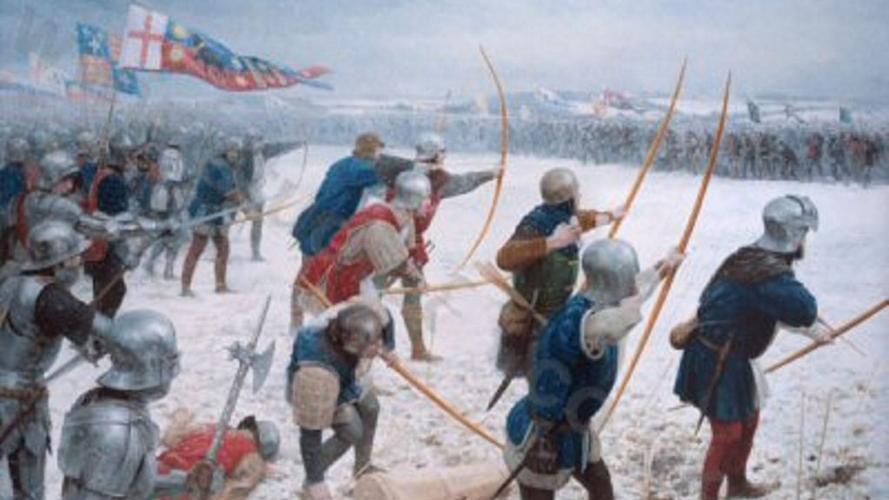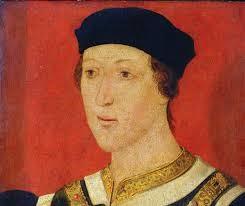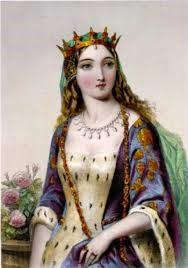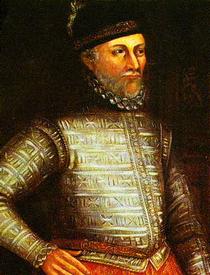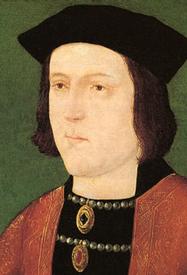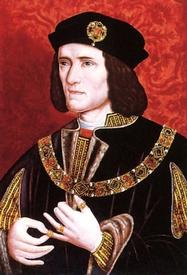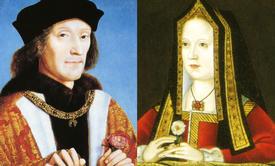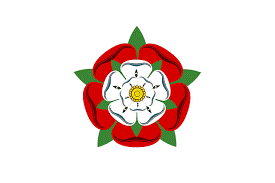Between 1455 and 1485, England witnessed a series of battles that would later come to be known as the Wars of the Roses. They are known as such because of the symbols of the two prominent families who fought it: The white rose of the house of York and the red rose of the house of Lancaster. In just thirty years the English crown would change hands seven times, two Kings would be assassinated and the bloodiest battle to ever take place on British soil would be fought.
The story of the Wars of the Roses is widely acknowledged to have been the basis for the epic Game of Thrones novel and television series. Of course, there were no dragons and magic in the real wars, but the series does accurately capture the forces that drove them – ambition, betrayal, lust, fatally weak leadership leaving a power vacuum, powerful men and women ruthlessly eliminating their enemies. Forget the fantasy; the real thing was more interesting. The real people involved are more interesting. These years were dominated by a variety of characters – colourful, fragile, callous – united only by their will to fight remorselessly to clinch the crown of England.
Background
Both the houses of York and Lancaster had a claim the throne through their descent from King Edward III, who died in 1377. Until 1422 the kingdom was under the stable leadership of a Lancastrian monarch, Henry V, the valiant warrior King who led the English army to the famous victory over the French at Agincourt in 1415. Henry was the undisputed King, but the domestic peace he presided over would not last.
In August 1422 King Henry died suddenly while on military campaign in France. His son, also named Henry, was only nine months old. A council was appointed to protect the new baby King and effectively rule the country until he came of age, and so began the bickering and political manoeuvring that saw the council become the first battleground of the wars that would follow.
The baby King, Henry VI, grew up to be a pitiful leader. Far more interested in the arts than in politics or war, he may have proved more effective if his father had lived long enough to secure his dynasty or perhaps provide a role model of an efficient, battle-hardened King. But as it was, Henry was thrust into a world of scheming and violence for which he was woefully unsuited. He was fortunate, then, to have a wife who did belong in that world. In 1445, Henry married Margaret of Anjou, a formidable and savvy Frenchwoman who would spend most of her life fighting Henry’s wars for him.
Henry’s weak leadership was allowing lawlessness to develop in his realm, and historian Dan Jones explains that in June 1450 the peasants of Kent marched on London in protest at the illegal taxes which were being forced on them. The peasants ran riot in the city and demanded that they be handed the hated treasurer, Lord Sey, who they blamed for much of their ills. Holed up in the Tower of London, Sey would have been safe from the mob if King Henry had done what any effective King would do: deny the demand, speak to the rebels and eventually have his troops swarm the area and arrest the ringleaders for treason. But Henry was not an effective King. Terrified of the mob, he handed Lord Sey to them and fled to the midlands, abandoning his capital city to its fate. After the peasants beheaded Sey at the guildhall, it was left to the Mayor of London to defend the city and after a day of intense fighting he managed to push them back across London Bridge and lock the city gates. Hundreds of bodies floated in the River Thames, causing a putrid smell in the summer heat, and the King was no where to be seen. It was a perfect encapsulation of his miserable reign.
The King may have fled to the midlands, but his wife had stayed behind. Only 20 years old, Margaret took control of re-establishing order in the city, and decreed that any remaining rebels would be pardoned if they laid down their arms and returned to their homes. Most of them accepted the terms and scuttered back to Kent, but a few hardy souls stayed behind in the hope of having an audience with the King. Margaret did indeed ensure that they were brought before the King, but there would be no consultation. The remaining rebels were paraded before Henry when he returned to London and executed on Margaret’s orders. Margaret, not Henry, was the decisive ruler who would protect the Lancastrian cause.
Margaret could well have been the saviour of the kingdom and ruled happily on her husband’s behalf for years to come. Unfortunately, there was another figure who had decided it was his job to protect the realm. Richard, Duke of York, was a fearsome warrior with a gargantuan ego who also happened to be heir to the throne, as Henry and Margaret were still childless. Returning from Ireland, where he had ruled on the King’s behalf, he marched on London with 5,000 men on the 27th September and interrupted a meeting of Parliament that afternoon to demand he be named the King’s chief advisor. But that job had already been given to someone else – the Earl of Somerset, who just happened to be Margaret’s closest ally. With a feckless King on the throne, Richard and Margaret were effectively vying with each other to be the ultimate ruler of England. There was only room for one of them.
The Mad King
Events came to a head when King Henry lapsed into a bout of insanity in 1454. Under enormous pressure and having just lost English lands in France, Henry had probably suffered what modern doctors would diagnose as a mental breakdown. Of course, his contemporaries did not understand this. All they understood was that the King had gone insane, and someone would have to rule in his place.
By now, Margaret had given birth to Henry’s only son, Edward, meaning that York was no longer heir to the throne. Realising that this may be his only chance of gaining power, he quickly had his powerful clique of barons, led by his nephew Richard Neville, Earl of Warwick, declare him the protector of the realm. Warwick’s role in this and other later power grabs would earn him the title of ‘Kingmaker’. In any case, Richard of York had replaced Margaret as the de facto ruler of England.
Then everything changed. Henry suddenly woke up from his insanity in February 1455 and re-installed Somerset as his chief advisor. York was forced to flee, fully aware that Margaret would use her opportunity to try and get rid of him for good. He fled north to raise an army, while Margaret remained in London to raise her own army. As wife of the Lancastrian King, she and her supporters were known as the Lancastrians, while York and his allies were naturally known as the Yorkists. The Wars of the Roses had begun.
The Battle of St. Albans, 1455
On 22nd May 1455, York and Warwick led an army south and were met by the King and his army at St. Albans. The fighting was brief but vicious, with both armies fighting house by house, building by building, in the narrow town streets. Henry, fighting in his first ever battle, was hopelessly out of his depth. His army was crushed, he was taken prisoner, and York was re-installed as the protector of the realm. Having lost her husband and her key ally, the Earl of Somerset, who was killed in the fighting, Margaret was forced into exile with her young son.
A fragile peace
York’s position as protector was legally tenuous. Although clearly a weak ruler, the King was still considered to be appointed by God and could not just be got rid of. Indeed, while taking him prisoner at St. Albans, York and his allies had knelt before the King and sworn their loyalty to him. But how could this be? Had they not just raised an army against him? Was this not treason? Furthermore, the King was no longer considered insane, leaving doubts about the extent to which a protector was required.
York tried to sure up his position by appointing his allies to key posts in government, but this left him politically isolated. All the while, Margaret was corresponding with the many powerful figures who felt ignored by York, encouraging them to oppose him. When he tried to pass a controversial tax law, he was voted down and forced to resign his post. He fled north again, immensely disappointed that his time in power had not been what he expected it to be.
Margaret swooped in and planned her next move. Determined to strike York while he was on the run, she raised a huge army and marched north, meeting the Yorkist army at Blore Heath in Staffordshire on September 23rd, 1459. Despite her numerical advantage her army was soundly defeated, but she was undeterred. She caught up again with York at a castle in Ludlow Bridge, Shropshire, and this time made sure she had the King himself with her. Again, we turn to Dan Jones for an description of how, as the Yorkist troops looked out from their castle on October 12th, they could see the royal standard fluttering in the field nearby which signalled that the King was outside their gates. Doubtful now about the legitimacy of their cause, huge numbers of soldiers used the early onset of darkness that evening to sneak out of the castle and defect to the King. Realising they had not a hope of victory, York and Warwick also made good their escape, with York fleeing back to Ireland and Warwick to France.
Margaret was not happy. She knew that it was not enough to have her enemies fleeing into exile; as long as York was alive, he remained a very dangerous man. But it was not just him she had to worry about.
The Kingmaker shows his value
While the royal army was in the midlands in June 1460, the Earl of Warwick marched into London with a newly raised army. He headed north immediately and scored an unexpected victory over Henry and Margaret in sweltering heat on July 10th at Northampton. Henry was again taken prisoner and Warwick sent for York to return to England and re-claim his power.
Richard Neville, Earl of Warwick, earned the moniker 'Kingmaker'
Just as Margaret had not been satisfied with her apparent victory the previous autumn, York was not fully satisfied as he returned to England that summer. It was one thing for the King to be in his custody, but he knew the real threat was Margaret and her son, who had both managed to flee to Scotland. Still, he also knew that he now had her firmly on the back foot. Not content with the role of protector anymore, he made a brazen attempt to have himself crowned King, but even his allies were aghast at this idea. Instead, York had to settle for the next best thing: he was named Henry’s successor.
A new Duke of York emerges
York’s move meant that Margaret’s young son had been disinherited, something which she absolutely could not abide. She immediately began gathering forces in the north of England and York rushed to meet her. York was never a man short on confidence, and his success over the last few months had only inflated his ego. Keen to vanquish the only remaining threat to his power, he had raced north with a force of only 6,000 men. It was only when he confronted Margaret on December 21st at Wakefield that he realised he had fatally underestimated the strength of her support. His army was totally outnumbered, and he was captured in the ensuing battle. Standard practise at the time dictated that a high-ranking noble such as York be treated with respect as a prisoner of war, but he knew as well as anyone that there was no chance of him escaping with his life. Margaret’s men placed a mock paper crown on his head and executed him. His head, still complete with the mock crown, was stuck on a pole and displayed in the town of York for all to see.
The conflict subsided over Christmas but was re-ignited when Margaret won victory at the second battle of St Albans over Warwick on February 17th, 1461. It looked for all the world that the Lancastrians had won the war and Margaret had secured a dynasty for her husband and son. As she set off for London, she must have been looking forward to parading through the streets as the people celebrated an end to the years of struggle.
But she had a new foe. Unbeknownst to her, the Duke of York’s 18-year-old son, Edward, was already marching on London with his own army. Tall, charismatic and handsome, he arrived before her on February 26th and immediately had himself crowned King Edward IV. England effectively had two Kings, and there was only one way to settle which one would remain. Edward marched north to hunt Margaret down.
The Battle of Towton, 1461
The Lancastrian and Yorkist armies met on Palm Sunday, 29th March 1461, on a field just outside the village of Towton in Yorkshire. As a brutal snowstorm raged, up to 65,000 men fought for most of the day until finally the Lancastrian lines began to crumble in the afternoon. With order in their ranks beginning to fall apart, the Lancastrians started to flee and the Yorkists chased them, mercilessly slaughtering even the many who surrendered. By the end of the day, around 28,000 bodies lay on the frozen field, making it the bloodiest battle ever fought on British soil.
Edward IV, who had been in the thick of the fighting alongside his men, was now the undisputed King of England, and the first phase of the Wars of the Roses was over. But Edward had not been able to kill his main enemies: Henry and Margaret had escaped with their lives and their son to Scotland. They lived to fight another day.
Edward scorns the Kingmaker
For three years, Edward IV ruled successfully. Rather than seek vengeance on the nobles who had supported the former King Henry, he allowed them to keep their titles and lands so long as they pledged their loyalty to him. This domestic peace was good for the economy, and desperately needed money started flowing back to the treasury. It seemed as though England was under the permanent rule of the Yorkists.
But Edward was not the only one in control. His mentor, the Earl of Warwick, had spent those three years crushing the last remains of Lancastrian support and wielded significant power. This was not a problem in itself as long as their priorities remained aligned, but a rift between them could plunge the kingdom back into chaos. Such a rift would manifest itself in the last hurdle Edward had to clear before becoming totally secure as King – finding a suitable bride.
As far as Warwick was concerned, he was the man to find a bride for his King. In 1464, he set sail for France and over the course of several weeks successfully negotiated a deal for Edward to marry the daughter of the French King. This was a massive coup, because it not only meant that Edward would marry a woman of suitable status, but it could potentially bring an end to the long years of conflict between England and France. This was the high point of Warwick’s career, and after his return to England he strolled triumphantly into a state gathering at Reading Abbey in September 1464 to announce the match. However, before he could even open his mouth he was blindsided by an announcement from the King himself. There was no need to worry about finding a royal bride, Edward declared, because he was already married. Five months earlier, while Warwick was immersed in negotiations in France, Edward had secretly married the daughter of a minor noble, Elizabeth Woodville. Marrying a woman of such low status was one thing, but Woodville’s background made it worse. For a start, she was a widow who already had two sons. Moreover, her father had fought against Edward at the battle of Towton, and her family, large and ambitious, had strong links to the Lancastrians.
Warwick bit his lip and congratulated the King, but he was incandescent with rage. The young King, still only 22, had sacrificed the political good of the realm on the altar of childish ideas about love and romance. Warwick had toiled to negotiate an incredible deal for his King, yet it would not count for anything. Edward had fallen for the oldest trick in the book and allowed himself to be seduced by the beautiful Elizabeth, and rumours alleged that she told him that she would not sleep with him unless they were married. To Warwick’s mind, Edward had made the momentous decision of who to marry with the wrong part of his body. When Woodville was crowned Queen of England in May 1465, Warwick was the only noble not to attend the lavish ceremony – a direct snub to the King and his bride. This was the first crack in the relationship between the two most powerful men in England, and it would develop into a deadly chasm.
In July 1465, former King Henry was captured and locked away in the Tower of London, adding to Edward’s security. But this could not paper over the fatal rift between him and Warwick. Through the mid-1460s the Woodville family elbowed their way to prominence and Warwick was side-lined, no longer the most influential man in the realm. The final straw came in June 1467, when Edward sent Warwick to France ostensibly to negotiate a trade deal. In fact, he was only sending him there to get him out of the way while he hosted the Burgundian family, France’s mortal enemy and strong Woodville allies. If there had been any doubts before about who had the King’s ear, there could not be after this. The Woodville family ran the show now, and Warwick was irrelevant. Having dedicated his adult life to the service Edward and his father, the old Duke of York, Warwick felt utterly betrayed. The question was – what was he going to do about it?
The Kingmaker strikes back
Warwick would not have to wait too long for his chance to re-claim power. In the summer of 1469, riots broke out in the north of England over unfair taxation, almost certainly orchestrated by Warwick’s allies. Edward marched north to try and raise an army, but quickly realised he could not muster the necessary support on his own. He would have to make a humiliating approach to his old mentor.
In July, Edward sent word to Warwick asking for his support, but received no reply. That’s because Warwick was in Calais with his own army. Worse still for Edward, he was not leading the army alone. Warwick was with Edward’s younger brother, the Earl of Clarence, who had just got married to Warwick’s daughter. This was an astonishing manoeuvre on Warwick’s part – not only had he turned the King’s own brother against him, but since Edward and Elizabeth were still childless the Earl of Clarence was the heir to the throne, and Warwick had just become his father-in-law. If nothing else, Warwick gets full marks for sheer audacity.
Landing in Kent on 16th July, Warwick and Clarence quickly took London and marched north to find Edward. On July 26th, the King’s army was routed and he was taken prisoner. But Warwick does not appear to have had an exit strategy. If he was serious about re-claiming power, he ought to have had the King declared illegitimate and killed him. But he stopped short of that, instead unleashing a systematic massacre of the Woodville family and their allies, culminating in the execution of Elizabeth Woodville’s father, the King’s father-in-law. Realising that he did not have sufficient support to replace Edward, Warwick was forced into a humiliating climbdown and bent the knee to him. Edward, who had based his early reign on forgiving his former enemies, issued an unexpected pardon to Warwick and Clarence. But the truce was a fragile one. By the end of the year, Warwick and Clarence were forced to flee back to France after they were implicated in further rebellions against Edward.
Humiliated and on the run, Warwick considered his options. One option was to retire and live the rest of his days in France. After all, he still had friends in France after the time he had spent negotiating there. But Warwick was not the type of man to meekly retire into the wilderness. Instead, he chose another option. He formed a new alliance with the one person who could claim to be an even more bitter enemy of Edward than he was. He formed an alliance with Margaret of Anjou.
The Lancastrians re-claim the throne
In the summer of 1470, Warwick was back. Sweeping across the kingdom with a small but mobile army, he caught the King’s guards by surprise in Doncaster. Edward was woken in the middle of the night to be told that enemy troops were only a mile away, and he was forced to make a dash for the coast and sail to Flanders. His wife Elizabeth, now pregnant, shrewdly sought shelter in Westminster Abbey.
Warwick joined Margaret in London and released Henry from captivity. He was duly re-crowned as King Henry VI on 13th October, but his second reign was to last less than a year.
The Battles of Barnet and Tewksbury, 1471
It did not take long for Edward to raise an army and head back to England. Landing in Yorkshire on 14th March 1471, he bulldozed his way south towards London. The dynamism with which he was operating could not have been in starker contrast to the feeble King Henry. His ten years in exile and captivity had not changed him, and a shambolic parade through London on Maundy Thursday only confirmed to Londoners what they had suspected – the King was still insane. That same day, Edward arrived in London and put Henry back in the tower. He would never see freedom again.
Edward IV was a formidable warrior
Led by Warwick, the Lancastrians marched towards London and were met by Edward’s Yorkists in Barnet, a few miles north of the city, on 14th April. In heavy fog, the Lancastrian army was overwhelmed, and Warwick was killed as he attempted to flee for his life. The shrewd and bombastic Earl, without whom Edward would never have become King, was no more. The Kingmaker was dead.
Edward still had a few loose ends to tie up. On 4th May, his Yorkist army defeated the Lancastrians at Tewksbury, a battle in which Henry and Margaret’s only son, Edward, Prince of Wales, was killed. Margaret was taken prisoner (she would be ransomed back to France in 1475, where she would die some years later). Now content that the Lancastrian line was finished, Edward got rid of his final problem. On the morning of 22nd May, the old King Henry VI was ‘discovered’ dead in his cell. The official cause of death was pure sadness that his son had died and his cause was lost, but there is no doubt that Edward organised for Henry to be murdered.
By June of 1471, Edward IV was once again the undisputed King of England, and he had no more serious enemies to worry about. What’s more, his wife Elizabeth had given birth to a baby son during her time in sanctuary in Westminster Abbey, securing an heir for his dynasty. To Edward, and to everyone in England, it seemed that the wars had ended in total Yorkist victory. But there was more turbulence to come.
Edward IV dies young
On 9th April 1483, 12 years of peace came to an end. Edward IV died suddenly at the age of 40. Five days later, the news reached his eldest son, who was now to be crowned Edward V. At only 12 years old, he tried to maintain his composure while people bowed before him and pledged their loyalty, just moments after he had learned about the death of his father. Distraught and overwhelmed, he sought comfort that day in his Uncle, Anthony Woodville, a dashing knight who had taken the young Edward under his wing as he grew up. Within months, the pair of them would be also be dead, murdered on the orders of another royal Uncle. Edward IV’s death had set in motion the last phase of the Wars of the Roses, where the throne would change hands a further two times and the Lancastrians, so often on the back foot throughout the saga, would claim ultimate victory.
The dead King’s will dictated that his younger brother Richard, Duke of Gloucester, be appointed protector of the realm until the new King came of age to take control for himself. Richard, who’s slightly hunched back disguised his brilliant skills as a soldier, wept openly when he heard of Edward’s death and was intent on following his brother’s wishes. Assuming there would be little controversy about him taking temporary charge, he headed to York for official mourning and entrusted his allies in London to ensure that the shift ran smoothly. But Richard had not counted on the naked political ambition of his in-laws. The years of peace had allowed the Woodville family to maintain their influence without antagonising anyone, but their ruthlessness had not left them. Having scrapped their way to the top, they were not about to allow Richard to take their power away from them, and they used their allies in London to overrule the King’s will. There was to be no protector of the realm. It would instead be the privy council, stacked with the Woodville’s and their allies, who would rule on the new King’s behalf.
Richard would not just stand by and let the Woodville family take control. After all, in his mind he was only acting on his dead brother’s final wishes, and his cause was therefore entirely justified. He suggested to Anthony Woodville that they meet on their way down to London to show that both sides of the royal family were united, and they met in Buckinghamshire on 29th April. Richard was charming and courteous to Woodville, who did not suspect that anything was amiss and readily informed his brother-in-law where their nephew, the new King, was staying for the night. The next morning, Richard took custody of the new King and had Woodville arrested for treason. The entourage moved down to London, with Richard having control of Edward.
Dan Jones explains that Richard’s plan was good, apart from one problem. Edward had spent the majority of his childhood with Anthony Woodville and did not believe for one second that he was a traitor. If anything, the new King was more inclined to believe that it was Richard, who he had only met a handful of times before, who was the traitor. Richard managed to have himself declared protector, but crucially was only allowed to claim the position until Edward V’s coronation, scheduled for 22nd June. After that, he would be hopelessly isolated, with Edward likely to side with the Woodville family if they decided to go on the attack against Richard.
Richard takes the crown for himself
Richard’s actions over the next few weeks ensured he would go down in infamy. After failing to secure any backing with the council in London, he realised he had overreached himself, and that in just a matter of days he would lose all his power and most likely his life. His only option now was to ensure that Edward did not ascend to the throne. He postponed the coronation, and on June 25th announced that Edward and his siblings were illegitimate, because the old King Edward had agreed to marry another woman before he married Elizabeth Woodville. It was a shockingly poor rationale and Richard provided no evidence to support his claim. But he did not need to. If the young Edward was illegitimate, he could not ascend to the throne under English law. Conveniently, that meant Richard was the rightful heir. The same day, a sham trial was organised for Anthony Woodville, who was convicted of treason and executed on the spot. With his enemies either killed or frightened into submission, Richard was formally offered the throne by his greatest ally, the Duke of Buckingham, who had hastily assembled a motley crew of knights and Lords to legitimise the process. Richard was duly crowned as Richard III.
Richard, Duke of York, had himself crowned Richard III
But what to do with Edward? In another stroke of luck for Richard, the problem seemed to just disappear. Edward and his younger brother, who Richard also took into his ‘custody’, mysteriously vanished and were never heard from again after that summer. Of course, it was not luck. Richard had organised their murder. The two princes were last seen by guards playing in the gardens within the walls of the Tower of London, emphasising the fact that they were only children, innocent boys who became collateral damage in the high stakes game between both sides of their family.
It is this heinous act for which Richard is most remembered, but it is unfair to suggest that he was an intrinsically evil man who was always intent on grabbing power. Rather, he was a man who felt he was entirely justified in trying to follow the will of his dead older brother and was prevented from doing so by the Woodville family. Eventually, Richard realised he had gone too far and did what he did in order to save his own skin. That may not justify the killing of his nephews, but it shows that his were not so much the actions of a wild murderous man as they were of a desperate man. The Woodville family may have lost in the end, but they were no innocent party themselves.
Richard's story should also be redeemed by his actions as King. He had always had a reputation for being fair to the common people and developed this during his reign, giving grants to intelligent children who may not otherwise have afforded an education, establishing a postal service and making sure laws were published in English rather than Latin so that more people could understand them.
The rise of Henry Tudor
Margaret of Anjou played a pivotal role in the earlier phases of the wars, but it was another Margaret who would ultimately do what she could not: place her son on the throne. The other Margaret was not of royal stock – she was barely of noble stock – and her son’s unlikely rise from the child of an obscure Welsh nobleman to King of England is one of the most stunning rags to riches stories in history.
In January 1457, while the old Duke of York was clinging to power as protector for King Henry VI, 13-year-old Margaret Beaufort gave birth to a baby boy in Pembroke castle in Wales. Even by medieval standards, her age made her incredibly young to be having a baby, and the fact that she never had any other children is likely because of the traumatic labour the young girl endured. She would have to pin all her hopes in her boy, who she christened Henry. Baby Henry was not born into a world of promise. His father, Edmund Tudor, was the King’s illegitimate half-brother who had died from plague months before the birth. His mother was a teenaged widow, who was forced to rely on Edmund’s brother Jasper for support.
Jasper and Edmund’s mother was Catherine of Valois, wife of the valiant King Henry V and mother of King Henry VI. Unfortunately, their father was not Henry V, but a Welsh squire named Owen Tudor who had an affair with Queen Catherine. Although they could count the King as a close relation, the fact that their claim to royalty came from their mother’s side essentially made them irrelevant.
When Henry was two months old, Margaret left Pembroke to marry Henry Stafford, and under medieval law this meant that she was forced to leave young Henry behind in the care of his Uncle Jasper. Jasper and the boy were safe as long as Henry VI remained on the throne, but after Edward IV took firm control of the realm in 1471 they fled to France. Henry Tudor most likely would have remained in France for the rest of his life, were it not for those turbulent weeks in the spring and early summer of 1483 when Richard III came to the throne.
Since Henry VI and his son had been killed in 1471, Henry Tudor was the last surviving Lancastrian claimant to the throne of England. Richard, though a Yorkist King, had made some powerful Yorkist enemies with his power grab in 1483. It was at this point where Margaret Beaufort, who had not seen her son since he was a teenager during Henry VI’s brief re-installation in 1471, saw her opportunity. Margaret had spent decades treading the line between Yorkist and Lancastrian. Although she was nominally a Lancastrian, she had been in the favour of Edward IV through her third marriage, to one of the King’s most powerful allies, Lord Thomas Stanley. It was also through this marriage that she had formed a close relationship with Elizabeth Woodville, the deposed Queen and mother of the boys Richard had murdered.
Margaret made a bold proposition to the disaffected Yorkists. If her son Henry could manage to take the throne, he would marry Elizabeth of York, the eldest daughter of Edward IV and Elizabeth Woodville, to unite the two houses and end the wars once and for all. Woodville and her allies agreed to the idea. Henry, with his mother’s encouragement and funds, attempted a coup in the Autumn of 1483, but the rebellion was crushed by King Richard before the young Tudor was even able to land in Britain. But the insurrection could not be put off for long, and in August 1485 Henry Tudor landed in Pembrokeshire and took his first steps on British soil in over ten years. Heading east into England, he received a huge sum of money from his mother which allowed him to pay the soldiers he had recruited. Suddenly, the young pretender with a desperately weak claim to the throne was a real threat to Richard.
Henry Tudor and Elizabeth of York: A match to bring the two houses together
Henry’s army met Richard’s on the 22nd August 1485. Significantly outnumbered, Henry tried to take the fight to Richard by marching towards him at dawn, leaving the King’s army rushing to get ready. The fighting was ferocious, with Henry and Richard in the thick of it. Just as the battle seemed to be going Richard’s way, Lord Thomas Stanley, Henry’s step-father who had been waiting on a nearby ridge with his own army, entered the fray in Henry’s favour. In the resulting scramble, Richard was thrown from his horse and killed. Shakespeare – writing during the reign of Henry’s granddaughter Elizabeth I – would dramatise the event by having Richard exclaim ‘a horse, a horse! My kingdom for a horse!’ In reality, Richard’s end was far too swift for him to have said anything so colourful, and sources suggest he actually only managed a desperate cry of 'treason!' before he died.
With Richard dead, the crown of England was taken from him and placed on Henry Tudor’s head. Tudor, a complete nobody with barely a claim to the throne, had ended the Wars of the Roses. The Tudor dynasty had begun.
After 1485
Henry Tudor married Elizabeth of York in 1486, uniting the houses of York and Lancaster. This unification was marked with the creation of a symbol, which merged the white rose of York with the red rose of Lancaster to produce the Tudor rose. Though a political marriage arranged by their mothers, Henry and Elizabeth developed a genuine love for each other and had several children, including England’s most famous King, Henry VIII.
Thirty years is a paltry span of time in the grand scheme of things, yet those thirty years in the 15th century saw England shaken to its core. So many powerful people entered the fray, yet after the decades of back-stabbing, violence and political manoeuvring it was an absolute outsider who emerged as the ultimate victor, and who would go on to found one of England’s most famous dynasties.
The red rose of Lancaster and the white rose of York were combined to form the Tudor Rose
Acknowledgements
The Ministry of History is not an academic source. Our pieces are written by writers who have been keen students of history for years and are well versed in, and influenced by, countless other writers and works. For this article specifically our sources have included:
'Britain's Bloody Crown' Documentary series (four episodes), written and presented by Dan Jones (2016).
'Wars of the Roses', article by Ben Johnson, published by historic-uk.com
'Wars of the Roses', article published by History.com
Images
Image one - thoughtco.com
Image two - historytoday.com
Image three - dangerouswomenproject.org
Image four - nerdalicious.com.au
Image five - hinkleypastpresent.org
Image six - nerdalicious.com.au
Image seven - battlefieldsofbritain.co.uk
Image eight - serious-science.org

